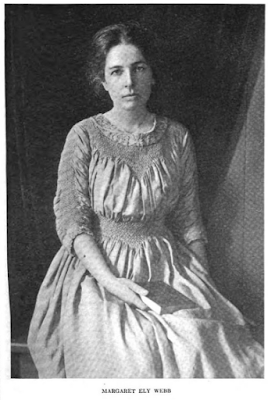Margaret Ely Webb
Margaret Ely Webb was born in Urbana, Illinois on
March 27, 1877 to a family with three sons. Margaret’s family was a highly cultured
and deeply religious New Jersey family in 1887. Music infused the family’s
everyday life; Webb’s mother played the piano, her father played the organ, and
a grandfather was an accomplished flutist. The importance of education was
stressed in the household and Webb would not be the only sibling to carve out a
distinguished career. One brother became a prominent architect in New York
City, another became an Episcopal rector for a large New Jersey parish, and a
third brother went on to a Columbia University professorship.
Margaret’s father, John
Burkett Webb, died in 1912. In 1918, Webb's mother, Mary Emeline Gregory, then married
Charles Albert Storke, a prominent citizen of Santa Barbara, California and
mayor from 1898-1901.
Webb studied in New York at the Art Students'
League and at Cooper Union. She lived in Boston and New Jersey, before settling
in Santa Barbara in 1922.
Webb was an important figure in the Arts and Crafts
movement of the early 1900s. She was known for her intricate, pen-and-ink
bookplate designs. According to the Santa Barbara Independent, "one
critic, writing in August 1908, confessed that the beauty of Webb’s plates had
shattered his prejudice against women artists." Webb created bookplates
for notable Santa Barbarans, including her step-brother, Thomas M. Storke.
In the 1940s, Webb took up woodblock printing
as a medium for bookplates. She also painted watercolors and oils. Webb is
primarily remembered for her work as an illustrator of children's literature;
her illustrations also appeared in many magazines. Webb
felt a special affinity for youngsters. One of the most popular books she
illustrated, now little known, was The House of Prayer by
Florence Converse, published in 1908.
Webb was also a talented musician and a
horticulturalist. The gardens at her home in Santa Barbara were admired
throughout the South Coast.
In 1950, Webb sold her longtime home on West
Micheltorena Street and moved to Mountain Drive, where she converted the garage
into her studio. Here, she enjoyed marvelous vistas for her landscapes and the
neighborhood children began a tradition of bringing her wildflowers every year
for her birthday
A collection of her watercolors of wildflowers
was given to the Santa Barbara Museum of Natural History, and her illustrations
would eventually become part of the collections of the Library of Congress and
the British Museum.
Webb’s work was well-known in Europe. In 1954, her bookplate art
was honored by the Dutch Bookplate Society. Interestingly, the journal of this
society was always sent unbound to members so they could have it bound to suit
their tastes, a throwback to the days of the arts and crafts movement.
Her illustrations also appeared in many
magazines, again, often oriented to young people. She also took up a study of
European folk melodies and their impact on classical music.
Margaret died on January 12, 1965, at the age of 87 in Santa Barbara County, California. She was buried in the Santa Barbara Cemetery.
Margaret died on January 12, 1965, at the age of 87 in Santa Barbara County, California. She was buried in the Santa Barbara Cemetery.


